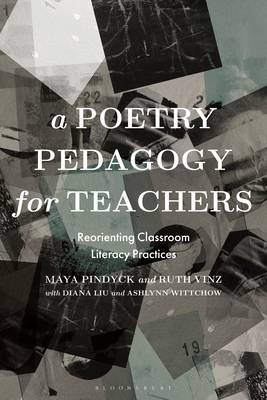
- Afhalen na 1 uur in een winkel met voorraad
- Gratis thuislevering in België vanaf € 30
- Ruim aanbod met 7 miljoen producten
- Afhalen na 1 uur in een winkel met voorraad
- Gratis thuislevering in België vanaf € 30
- Ruim aanbod met 7 miljoen producten
Zoeken
A Poetry Pedagogy for Teachers
Reorienting Classroom Literacy Practices
Maya Pindyck, Ruth Vinz, Diana Liu, Ashlynn Wittchow
€ 30,45
+ 60 punten
Omschrijving
A Poetry Pedagogy for Teachers generates imaginative encounters with poetry and invites educators to practice a range of poetry exercises in order to inform instructional approaches to reading and writing. Guided by pedagogical principles prompted by their readings of Wallace Stevens' "Thirteen Ways of Looking at a Blackbird," Maya Pindyck and Ruth Vinz provide critical discussion of prominent literacy practices in secondary classrooms and offer alternative approaches to encountering a text. They do this by way of experimental readings of Wallace Stevens' poem toward a set of thirteen pedagogical principles that anchor a pedagogy of poetic practices. The book also offers invitational exercises, the authors' own engagements with poetry practices, as well as student examples, visual modes of theorizing, and a gathering of relevant resources compiled by two classroom teachers. This is a book for secondary English teachers, teaching artists, English educators, college writing professors, readers and writers of poetry - both existing and aspirational - and any educator interested in poetry's capacities to pedagogically inform their subject matter and/or literacy practices.
Specificaties
Betrokkenen
- Auteur(s):
- Uitgeverij:
Inhoud
- Aantal bladzijden:
- 232
- Taal:
- Engels
- Reeks:
Eigenschappen
- Productcode (EAN):
- 9781350285385
- Verschijningsdatum:
- 20/10/2022
- Uitvoering:
- Paperback
- Formaat:
- Trade paperback (VS)
- Afmetingen:
- 155 mm x 231 mm
- Gewicht:
- 362 g

Alleen bij Standaard Boekhandel
+ 60 punten op je klantenkaart van Standaard Boekhandel
Beoordelingen
We publiceren alleen reviews die voldoen aan de voorwaarden voor reviews. Bekijk onze voorwaarden voor reviews.











